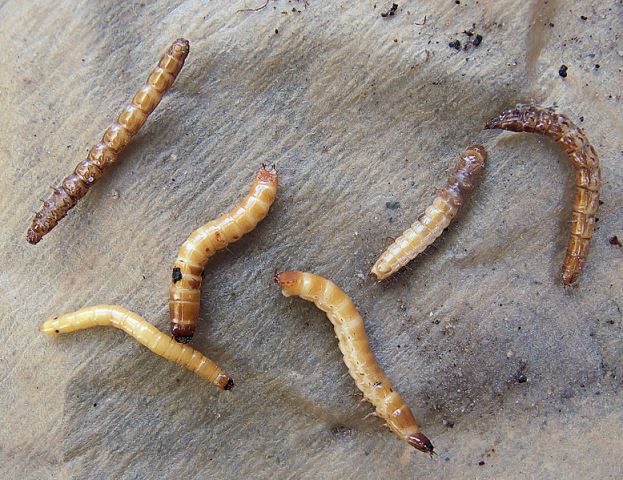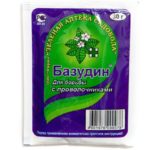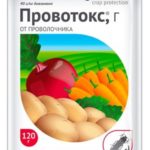Providing proper care for vegetables planted in the backyard, special attention should be paid to preventive measures to prevent the invasion of parasites. Insects of small size cause enormous damage to plants, reducing the yield or completely depriving it. The conductor is one of the pests that are difficult to remove. How to fight and how to get rid of the parasite in your own garden forever talk further.
Table of contents
- What does the wire look like and is it possible to get rid of it
- What plants are affected by a pest in the country?
- What is dangerous parasite?
- How to deal with the parasite in the garden and greenhouse?
- Preventive methods for the appearance of the wireworm on the potato and potato field in spring and autumn
What does the wire look like and is it possible to get rid of it
One of the most dangerous pests in the garden is the wireworm. What does he look like?It looks like an insect like worms from 1 to 4.5 cm long. There are three pairs of paws on a brown body. Distinguish from other underground inhabitants of the parasite can be on the dense casing, which consists of a solid chitinous shell. The peculiarity of the wireworm is that it is not an independent type of insect, it is the larva of the click beetle.
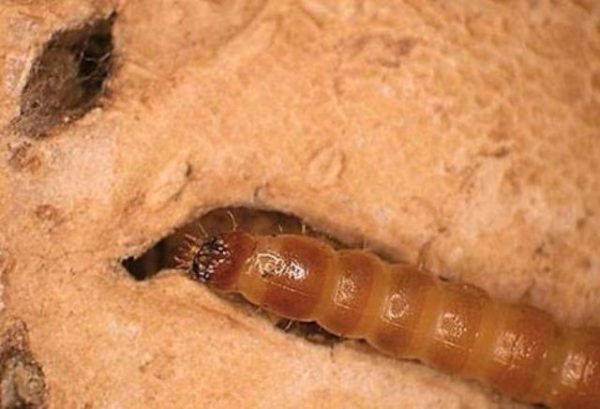
The larvae turn into a beetle for a rather long period of time - from 2 to 5 years. During this time, parasites cause considerable damage to vegetable crops, eating up the roots of plants. Winter wireworms spend in the soil, plunging 10-15 cm. Insects do not freeze out even in severe frosts, their vitality is explained by the ability to go deep into the ground up to 60 cm.
Click beetles appear in vegetable gardens already in April, as soon as the daytime temperature reaches 8-10 °. In early May, they lay eggs directly into the soil (under lumps, bushes). A new generation of wireworms is born 15-20 days later. During the first year of life, their torso reaches 5-7 mm.
What plants are affected by a pest in the country?
The voracity of the wireworm is obvious, which it does not eat. These are grain, melon and vegetable cultures, and also some ornamental plants. Treatments can be swollen seeds, seedlings, young shoots and tender stems. It even goes to the roots of fruit trees.
Of particular interest are the larvae to such plants:
- potatoes;
- corn;
- carrot;
- sunflower;
- salad;
- alfalfa;
- tobacco;
- melon;
- watermelon and others
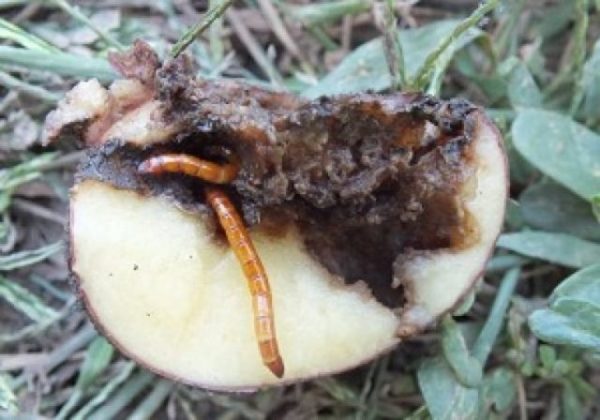
What is dangerous parasite?
The wireworm gnaws the tubers of the roots of vegetables and grain crops, which weakens the plant. The defeat of the pest can be noted for the slow growth of tops. Parasites make holes in root vegetables, which reduces the quality of the crop. In addition, the larvae are carriers of fungal infections and harmful bacteria.
In addition to the harvest, the wire is also dangerous for humans, which is the use of chemicals. Toxic substances are deposited not only in the fruits, but also in the soil, which adversely affects the subsequent plantings of the new season. This is due to soil contamination, violation of its structure and microflora due to the death of earthworms and beneficial microorganisms.
How to deal with the parasite in the garden and greenhouse?
The larvae can live both in the open field and in the greenhouse, therefore, it is worth treating the beds for prophylaxis with any method of growing vegetables. As active agents on the parasite, special preparations are used, which include chemicals. Not all gardeners resort to radical methods of dealing with wireworm; therefore, along with chemicals, popular recipes are used.
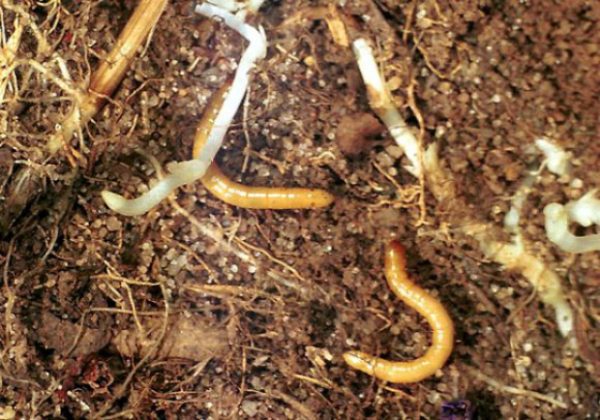
The use of special drugs to protect crops
It so happens that the popular methods used do not give a positive result, the parasite continues to actively harm crops.. Special chemicals come to protection, which need to be used only in accordance with the instructions in the instructions. Particular caution should be exercised in measuring the dose, it is strictly prohibited to increase the recommended indicator.
One of the new developments in agrochemistry is the drug Nemabakt, which is obtained by combining two different species of organisms (predatory nematodes and bacteria). The principle of the agent is the penetration of the nematode inside the wireworm. There, it releases a bacterium that destroys the insides of the pest. They in turn feed the nematode. There is no chance for survival from the wireworm.
To fight the larvae can cultivate the land:
- Prestige;
- Provotox;
- Basudin;
- Thunder-2;
- Diazinon and others.
- Prestige
- Basudin
- Thunder-2
- Diazinon
- Provotox
Insecticides are used at different stages of plant development, but any treatments are completed 20-30 days before the harvest begins. After the completion of harvesting, the preparations can be used for tillage. All parasites are afraid of poison, therefore, it will not be difficult to kill them.
Using folk methods to combat beetles in the garden
It is extremely undesirable to use insecticides in the country, and bio-based products cost money. Yes, and the time to buy them gardeners can not carve out because of the complexity of leaving the outskirts of the city in the center. People come to the aid of methods that have been tested for effectiveness for years.
- In early spring and in June, young shoots of almost every crop need weeding and loosening the soil. This rule of agrotechnology is also used as a measure to combat wireworm. Eggs, larvae and the beetles themselves, once on the surface, become food for birds. In addition, under the influence of the sun eggs become unviable.
- As traps, many gardeners plant corn or leaf lettuce in the aisle of vegetable crops, the roots of which are loved by wireworms. It will be necessary only to pull out growing shoots from the ground together with hordes of pests.
- Before planting, it is useful to water the soil with a weak solution of potassium permanganate (2 grams per bucket of water). In addition to the disinfecting effect of the composition will scare the parasites.
- The easiest way to deal with the wireworm is to dust the beds and between the rows with wood ash. Impregnated with ashes, the soil becomes not interesting to insects. You can throw a little ash in the hole and protect the crop at the planting stage.
- Mineral salts, sprinkled on the surface of the soil, will serve as a good fertilizer for vegetable crops and scare the wireworm.
- The procedure used to neutralize acidic soils, which is liming, reduces the pest population.
- It also helps to protect the crop ammonia, ammonium nitrate and lime. Treatment of the beds with these means in the required dosages will help to defeat the pest and save the crops in the future.
- You can also destroy the wireworm by eggshell, scattering it on the garden beds.
The most popular is the recipe, which includes a set of plants that are insecticides by nature:
- dandelion (200 g);
- nettle (500 g);
- celandine (100 g);
- coltsfoot (200 g).
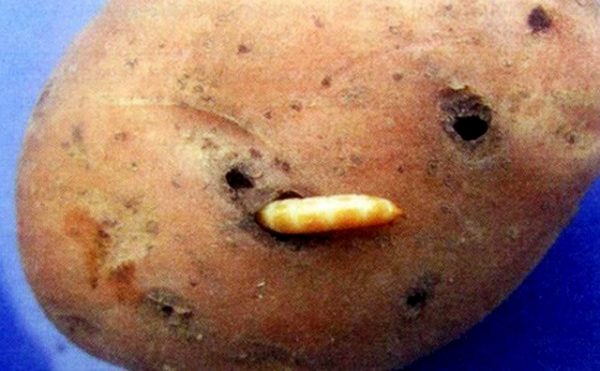
Components need to grind, pour warm water (10 l) and let it brew for 3-4 days. It is necessary to water the beds with a solution 2-3 times with 1 week breaks.
Preventive methods for the appearance of the wireworm on the potato and potato field in spring and autumn
Many gardeners believe that it is impossible to completely destroy the wireworm. Therefore, the purpose of preventive measures is to reduce the number of parasites, resulting in a reduced amount of damaged crops.
The following actions have been recognized as effective and acceptable agrotechnical measures that can reduce the larval population.
- Autumn cleaning beds with a careful selection of plant residues that can be used by pests for wintering.
- Digging the soil just before frost. Being close to the surface of the soil the larvae will freeze out. For the effectiveness of the method, the depth of digging should not be less than 25 cm.
- Wheatgrass and millet rhizomes attract larvaetherefore it is necessary to get rid of plants. Roots from the ground should be removed completely.
- Agrotechnika vegetable crops provides for the periodic loosening of the soil. In May and June, this should be done every week, so that the laid eggs of the beetle beetle find themselves under open sunlight. They die from overheating, which means that an increase in the population will be prevented.
- Trapping can also help reduce the number of parasites.. To do this, in different places in the garden, make small depressions in the ground, put some slightly damp grass or hay in them, moisten them and cover with a small board or pieces of slate. Every couple of days you need to look into the traps and remove, gathered for dinner wireworms. Potatoes are often used as bait - a favorite pest treat.
- Among the methods of struggle one of the most effective is the observance of crop rotation. Landing on the same place every year should not be done, a good harvest with this method is not removed, but to attract more insects will work. Especially the wireworm likes potatoes and is often found in the potato field. By the way, planting a tomato after it will not save the situation, since these two cultures are in the same group.
Systematic processingtimely weed control and careful cleaning of the garden after harvesting do not leave the larvae of the click beetle to survive. As you can see, it’s easy to get them out.
